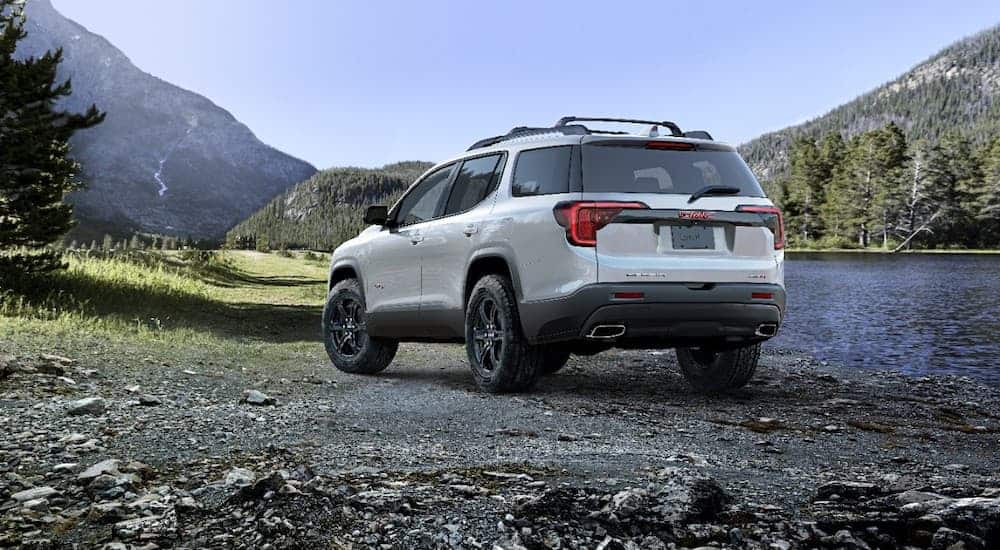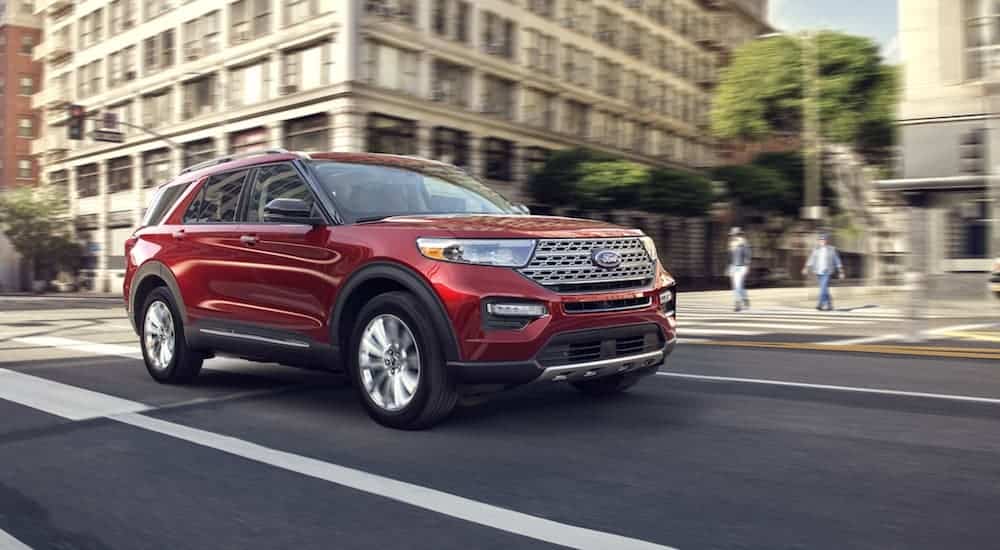Modern Day Mid-Size SUVs
When it’s time to purchase a new vehicle, we recommend the next vehicle you should be driving is a brand new 2020 mid-size SUV. Whether you’ve been a long time fan of mid-size SUVs or they’re piquing your curiosity for the very first time, there has never been a better time to start driving one and experience for yourself why mid-size SUVs are some of the best vehicles on the road today. We’ve decided to pit the 2020 GMC Acadia vs 2020 Ford Explorer to find out which one is worth your time and hard-earned money.
Both the 2020 Acadia and Explorer contain some top of the line features that have been appearing more prominently throughout the automotive industry that we’re excited to see on these two SUVs. Nowadays, you can expect your SUV to include a 4G Wi-Fi hotspot enabling the ability for you and your passengers to connect their wireless devices to the internet with ease. Having such a feature could revolutionize the way we go on camping trips, enabling us to have an internet connection ready to go at all times. Also featured on both vehicles is the integration of Apple CarPlay and Android Auto, both of which have been increasing in popularity and becoming a highly requested feature in the industry and we’re certainly happy to see them featured here. Not everything is the same, though, as we did find aspects of the 2020 GMC Acadia that we loved over the competition.
Where Things Matter

Something about the 2020 GMC Acadia that can’t be undermined is the lower price tag than that of the 2020 Ford Explorer. In fact, we see a price difference of 8% by going with the Acadia with its starting price of $33,800 and the Explorer starting at $36,675. We’d much rather put that extra money towards a higher trim or purchasing some necessary accessories for our SUV.
Things do start to heat up between the Acadia and Explorer when we start to look into the higher-tier trim levels. Going with the top of the line trim levels for both vehicles as a basis, we see an even greater price differential with the 2020 Explorer Platinum starting at $58,535 while the Acadia Denali starts at $52,590, an incredible $6,000 price difference. The Acadia Denali is a great choice, especially when considering how much more money you’re saving. These savings seem even more prominent when you take into consideration how many features are mutually shared between the two vehicles. The 2020 Acadia offers two safety packages known as Driver Alert Package I & II, which feature a majority of the same safety enhancements found on the 2020 Explorer, yet still retain a cheaper price tag overall.
Some of these technologies that make an appearance include a rear cross-traffic alert which will sound off a warning if the vehicle detects a moving vehicle or any other obstructions that you are in danger of colliding with when backing out of a busy parking space with oncoming traffic. Enhancing safety even further, both vehicles also feature rear park assist, which is another alert system designed to assist you in safely backing up at lower speeds when you’re leaving your driveway, for example. Rear park assist works alongside the Acadia’s rearview camera and can help with detecting pedestrians, bicyclists, animals, and even objects.
Opting for Driver Alert Package II will grant you some of the more enhanced safety features that are also found on the more expensive Ford Explorer. These features include lane keep assist paired with a lane departure warning, which provides very slight steering adjustments alongside an alert if the vehicle detects you are unintentionally drifting lanes. Furthering the number of similarities, we see an automatic headlamp featured on both vehicles that will dynamically turn your headlamps on and off depending on visibility and oncoming traffic. The fact of the matter is if we can get all of these identical safety features at a mere fraction of the price, then the Acadia certainly becomes an intriguing shopping choice.
The base model Acadia can comfortably seat seven, much like the Ford Explorer, but the overall interior design definitely sees an increase in quality with the Acadia. The materials used to design the interior consist of brushed aluminum accents and actual wood, making the Acadia feel more luxurious than its counterparts while still retaining a cheaper overall price tag.
Engine Choices and EPA-Ratings

Choosing an engine that works for you is an important part of shopping for a new vehicle as you want to make sure it’s both efficient and powerful. The 2020 Acadia has three engines to select from depending on your trim level, with a varying amount of power between the three. Every 2020 Acadia model comes equipped with a nine-speed automatic transmission to pair with its engine as well as Start/Stop technology. This improves fuel efficiency by automatically turning your engine off when you have come to a complete stop and instantly starts back up again when you continue accelerating.
Coming standard with the Acadia is a 2.5L 4-cylinder engine that produces 193 hp and 188 lb-ft of torque with an EPA-rating of 21 mpg in the city and 27 mpg on the highway and even supports lighter towing tasks thanks to its maximum towing capacity of 1,500 lbs. Although this engine is less powerful than the standard 2020 Ford Explorer engine, which is a 2.3L I-4 engine that produces 300 hp and 310 lb-ft of torque, it is dethroned by an upgraded engine choice; we can choose for the 2020 Acadia. This engine is a 3.6L V6 engine that has the ability to produce an impressive 310 hp and 271 lb-ft of torque and supports active fuel management, which dynamically adjusts the number of cylinders in use depending on the work-load of the engine. This engine has an EPA-rating of up to 25 mpg on the highway and has a maximum towing capacity of 4,000 lbs so it can certainly handle quite a bit.
The last engine we have the choice of fitting our Acadia with is a 2.0L turbocharged 4-cylinder engine making its debut in the Acadia lineup this year. This engine is being described by GMC as the “perfect blend of power and efficiency,” which we certainly agree with. This engine produces 230 hp and 258 lb-ft of torque and supports variable valve timing in addition to the aforementioned active fuel management technology. What variable valve timing does is alters the timing of a valve lift event and, in return, can produce better fuel efficiency for your engine. Because of this, the turbocharged 4-cylinder engine has an EPA-rating of achieving 28 mpg during highway travel.
The Verdict
Although both vehicles proved to be worthy adversaries to one another, we definitely felt the 2020 GMC Acadia was the better choice between the two for a few reasons, though most notably it came down to the overall price and the performance you will experience when driving a GMC Acadia over the Ford Explorer. Features that are shared between the two strengthen the core of the Acadia as we don’t have to sacrifice any extras even with a much lower price.
Even when we take the wide range of trims into consideration, this only proved to help the Acadia even more as we saw an increased number of top-notch features while it still retained its overall cheaper price point compared to the competitors. The GMC Acadia is certainly the mid-size SUV to consider for your next vehicle as we can assure you, the Acadia is here to stay, and we’re intrigued to see where things go from here in the automotive industry as the mid-size SUV makes more of an impact than it ever has before.



